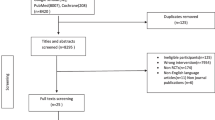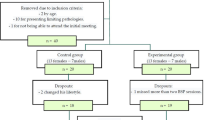Abstract
Purpose
A systematic search was conducted to study the efficiency of preventive educational interventions mainly focused on a biomechanical/biomedical model.
Methods
The Pubmed electronic database and the Cochrane Library were searched based on a combination of keywords related to low back pain (LBP) and posture education. Only randomized controlled trial (RCT) studying the efficiency on outcomes directly related to LBP of a preventive intervention programme mainly based on education of proper care of the back for subjects not seeking treatment were included. References of the articles meeting these inclusion criteria were also checked to identify other potential citations. Besides, a methodological study assessment of the included RCTs was performed.
Results
Nine studies, all conducted at the workplace were included in this review. Their mean quality level was low (5.1/12) and among the four studies with a huge sample size (n > 400 subjects), only one had an acceptable methodological quality score (6/12). The education interventions differed widely from one study to another. No significant differences between the control and education groups were found at the follow-up in eight out of the nine studies on the incidence of back pain, disability and sick leave.
Conclusions
The results of the RCTs included in this review suggest that educational interventions mainly focused on a biomechanical/biomedical model are not effective in preventing LBP. However, taking into account the methodological quality level of the RCTs as well as the very short and heterogeneous interventions often proposed, additional high-quality studies with a longer education period are needed to conclude that such interventions are inefficient.
Similar content being viewed by others
References
Balague F, Mannion AF, Pellise F, Cedraschi C (2011) Non-specific low back pain. Lancet 379(9814):482–491
Hillman M, Wright A, Rajaratnam G, Tennant A, Chamberlain MA (1996) Prevalence of low back pain in the community: implications for service provision in Bradford, UK. J Epidemiol Community Health 50(3):347–352
Picavet HS, Schouten JS (2003) Musculoskeletal pain in the Netherlands: prevalences, consequences and risk groups, the DMC(3)-study. Pain 102(1–2):167–178
Coste J, Delecoeuillerie G, Cohen de Lara A, Le Parc JM, Paolaggi JB (1994) Clinical course and prognostic factors in acute low back pain: an inception cohort study in primary care practice. BMJ 308(6928):577–580
Pengel LH, Herbert RD, Maher CG, Refshauge KM (2003) Acute low back pain: systematic review of its prognosis. BMJ 327(7410):323–325
Croft PR, Macfarlane GJ, Papageorgiou AC, Thomas E, Silman AJ (1998) Outcome of low back pain in general practice: a prospective study. BMJ 316(7141):1356–1359
Thorbjornsson CB, Alfredsson L, Fredriksson K, Michelsen H, Punnett L, Vingard E, Torgen M, Kilbom A (2000) Physical and psychosocial factors related to low back pain during a 24-year period. A nested case-control analysis. Spine 25(3):369–375
Burdorf A, Sorock G (1997) Positive and negative evidence of risk factors for back disorders. Scand J Work Environ Health 23(4):243–256
Hoy D, Brooks P, Blyth F, Buchbinder R (2010) The Epidemiology of low back pain. Best Pract Res Clin Rheumatol 24(6):769–781
van Tulder M, Koes B, Bombardier C (2002) Low back pain. Best Pract Res Clin Rheumatol 16(5):761–775
Adams MA, Mannion AF, Dolan P (1999) Personal risk factors for first-time low back pain. Spine 24(23):2497–2505
Ramond A, Bouton C, Richard I, Roquelaure Y, Baufreton C, Legrand E, Huez JF (2011) Psychosocial risk factors for chronic low back pain in primary care—a systematic review. Fam Pract 28(1):12–21
Hoogendoorn WE, Bongers PM, de Vet HC, Houtman IL, Ariens GA, van Mechelen W, Bouter LM (2001) Psychosocial work characteristics and psychological strain in relation to low-back pain. Scand J Work Environ Health 27(4):258–267
Burdorf A, Naaktgeboren B, de Groot HC (1993) Occupational risk factors for low back pain among sedentary workers. J Occup Med 35(12):1213–1220
Hestbaek L, Leboeuf-Yde C, Manniche C (2003) Low back pain: what is the long-term course? A review of studies of general patient populations. Eur Spine J 12(2):149–165
Bakker EW, Verhagen AP, van Trijffel E, Lucas C, Koes BW (2009) Spinal mechanical load as a risk factor for low back pain: a systematic review of prospective cohort studies. Spine 34(8):E281–E293
Mitchell T, O’Sullivan PB, Burnett A, Straker L, Smith A, Thornton J, Rudd CJ (2010) Identification of modifiable personal factors that predict new-onset low back pain: a prospective study of female nursing students. Clin J Pain 26(4):275–283
Kwon BK, Roffey DM, Bishop PB, Dagenais S, Wai EK (2011) Systematic review: occupational physical activity and low back pain. Occup Med 61(8):541–548
Burdorf A, van Riel M, Brand T (1997) Physical load as risk factor for musculoskeletal complaints among tank terminal workers. Am Ind Hyg Assoc J 58(7):489–497
Videman T, Rauhala H, Asp S, Lindstrom K, Cedercreutz G, Kamppi M, Tola S, Troup JD (1989) Patient-handling skill, back injuries, and back pain. An intervention study in nursing. Spine 14(2):148–156
Mundt DJ, Kelsey JL, Golden AL, Pastides H, Berg AT, Sklar J, Hosea T, Panjabi MM (1993) An epidemiologic study of non-occupational lifting as a risk factor for herniated lumbar intervertebral disc. The northeast collaborative group on low back pain. Spine 18(5):595–602
Garg A (1992) Occupational biomechanics and low-back pain. Occup Med 7(4):609–628
Marras WS, Lavender SA, Leurgans SE, Fathallah FA, Ferguson SA, Allread WG, Rajulu SL (1995) Biomechanical risk factors for occupationally related low back disorders. Ergonomics 38(2):377–410
McGill SM (1997) Distribution of tissue loads in the low back during a variety of daily and rehabilitation tasks. J Rehabil Res Dev 34(4):448–458
Adams MA, Roughley PJ (2006) What is intervertebral disc degeneration, and what causes it? Spine 31(18):2151–2161
Hadjipavlou AG, Tzermiadianos MN, Bogduk N, Zindrick MR (2008) The pathophysiology of disc degeneration: a critical review. J Bone Joint Surg Br 90(10):1261–1270
Plouvier S, Renahy E, Chastang JF, Bonenfant S, Leclerc A (2008) Biomechanical strains and low back disorders: quantifying the effects of the number of years of exposure on various types of pain. Occup Environ Med 65(4):268–274
Marshall LW, McGill SM (2010) The role of axial torque in disc herniation. Clin Biomech 25(1):6–9
Zachrisson Forssell M (1980) The Swedish back school. Physiotherapy 66:112–114
Cecchi F, Molino-Lova R, Chiti M, Pasquini G, Paperini A, Conti AA, Macchi C (2010) Spinal manipulation compared with back school and with individually delivered physiotherapy for the treatment of chronic low back pain: a randomized trial with one-year follow-up. Clin Rehabil 24(1):26–36
Heymans MW, van Tulder MW, Esmail R, Bombardier C, Koes BW (2004) Back schools for non-specific low-back pain. Cochrane Database Syst Rev (4):CD000261
King PM (1993) Back injury prevention programs: a critical review of the literature. J Occup Rehabil 3(3):145–158
Lahad A, Malter AD, Berg AO, Deyo RA (1994) The effectiveness of four interventions for the prevention of low back pain. JAMA 272(16):1286–1291
Linton SJ, van Tulder MW (2001) Preventive interventions for back and neck pain problems: what is the evidence? Spine 26(7):778–787
van Poppel MN, Hooftman WE, Koes BW (2004) An update of a systematic review of controlled clinical trials on the primary prevention of back pain at the workplace. Occup Med (London) 54(5):345–352
Maher CG (2000) A systematic review of workplace interventions to prevent low back pain. Aust J Physiother 46(4):259–269
Gatty CM, Turner M, Buitendorp DJ, Batman H (2003) The effectiveness of back pain and injury prevention programs in the workplace. Work 20(3):257–266
Hignett S (2003) Intervention strategies to reduce musculoskeletal injuries associated with handling patients: a systematic review. Occup Environ Med 60(9):E6
Verbeek JH, Martimo KP, Karppinen J, Kuijer PP, Viikari-Juntura E, Takala EP (2011) Manual material handling advice and assistive devices for preventing and treating back pain in workers. Cochrane Database Syst Rev (6):CD005958
Martimo KP, Verbeek J, Karppinen J, Furlan AD, Takala EP, Kuijer PP, Jauhiainen M, Viikari-Juntura E (2008) Effect of training and lifting equipment for preventing back pain in lifting and handling: systematic review. BMJ 336(7641):429–431
Tveito TH, Hysing M, Eriksen HR (2004) Low back pain interventions at the workplace: a systematic literature review. Occup Med (London) 54(1):3–13
Furlan AD, Pennick V, Bombardier C, van Tulder M (2009) 2009 updated method guidelines for systematic reviews in the Cochrane Back Review Group. Spine 34(18):1929–1941
Daltroy LH, Iversen MD, Larson MG, Lew R, Wright E, Ryan J, Zwerling C, Fossel AH, Liang MH (1997) A controlled trial of an educational program to prevent low back injuries. N Engl J Med 337(5):322–328
Donchin M, Woolf O, Kaplan L, Floman Y (1990) Secondary prevention of low-back pain. A clinical trial. Spine 15(12):1317–1320
Jensen LD, Gonge H, Jors E, Ryom P, Foldspang A, Christensen M, Vesterdorf A, Bonde JP (2006) Prevention of low back pain in female eldercare workers: randomized controlled work site trial. Spine 31(16):1761–1769
Reddell CR, Congleton JJ, Dale Huchingson R, Montgomery JF (1992) An evaluation of a weightlifting belt and back injury prevention training class for airline baggage handlers. Appl Ergon 23(5):319–329
van Poppel MN, Koes BW, van der Ploeg T, Smid T, Bouter LM (1998) Lumbar supports and education for the prevention of low back pain in industry: a randomized controlled trial. JAMA 279(22):1789–1794
Walsh NE, Schwartz RK (1990) The influence of prophylactic orthoses on abdominal strength and low back injury in the workplace. Am J Phys Med Rehabil 69(5):245–250
Warming S, Ebbehoj NE, Wiese N, Larsen LH, Duckert J, Tonnesen H (2008) Little effect of transfer technique instruction and physical fitness training in reducing low back pain among nurses: a cluster randomised intervention study. Ergonomics 51(10):1530–1548
Lavender SA, Lorenz EP, Andersson GB (2007) Can a new behaviorally oriented training process to improve lifting technique prevent occupationally related back injuries due to lifting? Spine 32(4):487–494
Kraus JF, Schaffer KB, Rice T, Maroosis J, Harper J (2002) A field trial of back belts to reduce the incidence of acute low back injuries in New York city home attendants. Int J Occup Environ Health 8(2):97–104
Burton AK, Balague F, Cardon G, Eriksen HR, Henrotin Y, Lahad A, Leclerc A, Muller G, van der Beek AJ (2005) How to prevent low back pain. Best Pract Res Clin Rheumatol 19(4):541–555
Hartvigsen J, Lauritzen S, Lings S, Lauritzen T (2005) Intensive education combined with low tech ergonomic intervention does not prevent low back pain in nurses. Occup Environ Med 62(1):13–17
Nilsen P, Bourne M, Verplanken B (2008) Accounting for the role of habit in behavioural strategies for injury prevention. Int J Inj Contr Saf Promot 15(1):33–40
Weber M, Cedraschi C, Roux E, Kissling RO, Von Kanel S, Dalvit G (1996) A prospective controlled study of low back school in the general population. Br J Rheumatol 35(2):178–183
Wai EK, Roffey DM, Bishop P, Kwon BK, Dagenais S (2010) Causal assessment of occupational lifting and low back pain: results of a systematic review. Spine J 10(6):554–566
Wai EK, Roffey DM, Bishop P, Kwon BK, Dagenais S (2010) Causal assessment of occupational carrying and low back pain: results of a systematic review. Spine J 10(7):628–638
Wai EK, Roffey DM, Bishop P, Kwon BK, Dagenais S (2010) Causal assessment of occupational bending or twisting and low back pain: results of a systematic review. Spine J 10(1):76–88
Roffey DM, Wai EK, Bishop P, Kwon BK, Dagenais S (2010) Causal assessment of awkward occupational postures and low back pain: results of a systematic review. Spine J 10(1):89–99
Henrotin YE, Cedraschi C, Duplan B, Bazin T, Duquesnoy B (2006) Information and low back pain management: a systematic review. Spine 31(11):E326–E334
George SZ, Childs JD, Teyhen DS, Wu SS, Wright AC, Dugan JL, Robinson ME (2011) Brief psychosocial education, not core stabilization, reduced incidence of low back pain: results from the prevention of low back pain in the military (POLM) cluster randomized trial. BMC Med 9(1):128
Conflict of interest
None.
Author information
Authors and Affiliations
Corresponding author
Rights and permissions
About this article
Cite this article
Demoulin, C., Marty, M., Genevay, S. et al. Effectiveness of preventive back educational interventions for low back pain: a critical review of randomized controlled clinical trials. Eur Spine J 21, 2520–2530 (2012). https://doi.org/10.1007/s00586-012-2445-2
Received:
Revised:
Accepted:
Published:
Issue Date:
DOI: https://doi.org/10.1007/s00586-012-2445-2




